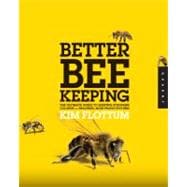
Kim Flottum brings a rich background of plant science, honey bee research, and basic farming to his 30 years as the editor of Bee Culture magazine, where his main occupation has been finding the answers to the multitude of questions that beginning, intermediate, and even advanced and experienced beekeepers bring to the table. He teaches beginning and advanced beekeeping courses, travels extensively to educate and lecture, and contributes to a variety of other publications on the basics of honey bees and beekeeping biology, the business of bees and pollination, producing and using varietal honeys, and a host of other subjects. He is the author of The Backyard Beekeeper, First Time Beekeeping, In Business with Bees, and Common Sense Natural Beekeeping. His books, magazine articles, interviews, and blogs are widely read for both their fundamental and advanced contribution to beekeeping knowledge. He is beekeeping’s leading advocate for fundamental honey bee safety, including ensuring excellent honey bee health, providing extraordinary forage, and minimizing the use of agricultural pesticides.
Introduction
Chapter 1: Growing Your Operation: How Big Do You Want to Get?
Trading Time for Money
Buy Preassembled Frames
Planning Ahead Saves Time and Money (But You Knew That)
Use It Up, Wear It Out
Business Goals and Bigger Pictures:
1. Where Are You Now?
2. Where Do You Want to Be?
3. How Will You Get There?
Buying Equipment
Standardization and Value
The Mercy Buy
Places to Put More Bees
Breakthrough: Lease Land for Beeyards
Expanding Your Honey House
New Ways to Expand
More Better Honey
Chapter 2: A New Look at Honey Production, or if Muhammad Won’t Come to the Mountain...
What It Once Was and Why It Changed
How Beekeeping Changed
More Change: Honey Money
A Price to Be Paid
Non-Agricultural Areas
Expanding Natural Bloom
Early Nectar Crops, Then Farm Crops
Migratory Beekeeping for Nectar Crops
Planning a Honey Crop
Types of Honey Crops
Planting Perennial Shrubs and Bushes
Long-Term, Permanent Plantings
Growing Your Own, with Help
Other Cost Considerations
How Much Land Is Required?
Working with Landowners with Lots of Land
Costs per Acre
More Land: Bigger, Better, More Complicated
Recommended Plantings for Honey Bees
Shrubs and Bushes
Cover Crops
Wildflowers
Permanent Plantings
This Land Is My Land, This Land Is Your Land
Types of Contracts
Chapter 3: Royalty: Finding the Best Queen There Is
Royal Lineage
The Queens We Can Get
What Do You Want from Your Bees?
Know What You Want
Hybrids
Survivor Queens
What Kind of Beekeeper Are You?
What Kind of Beekeeper Are You, Really?
Buying Queens
Mated Production Queens
Uncapped Queen Cells
Getting Queen Cells
Acquiring Virgin Queens
Raising Your Own Queens
Getting Breeder Queens
Raising Production Queens
Random Queen Production
The Starter/Finisher: The King of Queen-Rearing Techniques
The Cloake Board Method
Background Check for Drone Colonies
Chapter 4: The Working Class or the Bees that Beekeepers Keep
Preventing Springtime Swarming
Before Spring Arrives
Early-Season Feeding
Opening and Repacking the Colony After Feeding
Reducing Congestion in the Brood Nest
Equalizing Colonies, Discarding Dinks
Reversing
Making Spring Splits
Making Summer Splits
All About Honey Production
Measuring Growth
Preventing a Welfare Bee Population
Pests and Other Problems
Rallying Cry: Varroa Mite Resistance or Death
Signs of Hope
Trapping, Avoidance, and IPM
Chemicals
The Rest of the Lot
Controlling Nosema
Chapter 5: Wintering Your Bees, or Baby, it’s Cold Outside
Winter Rules
Unnatural Habits
From the Past
Take Care of the Bees
The Natural Question
The New Nosema
The Golden Rule
How Much Honey?
Too Cold Too Long
Protection
When It’s Really Cold
Planning Your Wrap
Pollen
Common Sense and Practical Facts
Summary
Glossary
Resources
Suppliers
Index
Photographer Credits
About the Author
Acknowledgments
The New copy of this book will include any supplemental materials advertised. Please check the title of the book to determine if it should include any access cards, study guides, lab manuals, CDs, etc.
The Used, Rental and eBook copies of this book are not guaranteed to include any supplemental materials. Typically, only the book itself is included. This is true even if the title states it includes any access cards, study guides, lab manuals, CDs, etc.